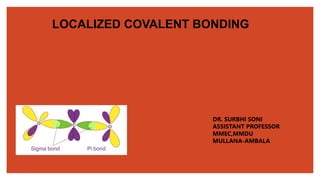
LOCALIZED COVALENT BONDING (2).pptx
- 1. LOCALIZED COVALENT BONDING DR. SURBHI SONI ASSISTANT PROFESSOR MMEC,MMDU MULLANA-AMBALA
- 2. Covalent Bond A chemical bond is a lasting attraction between atoms, ions or molecules that enables the formation of chemical compounds. The bond may result from the electrostatic force between oppositely charged ions as in ionic bonds or through the sharing of electrons as in covalent bonds. Examples of Lewis dot-style representations of chemical bonds between carbon (C), hydrogen (H), and oxygen (O). Lewis dot diagrams were an early attempt to describe chemical bonding and are still widely used today.
- 3. Elements having very high ionization energies are incapable of transferring electrons and elements having very low electron affinity cannot take up electrons. The atoms of such elements tend to share their electrons with the atoms of other elements or with other atoms of the same element in a way that both the atoms obtain octet configuration in their respective valence shell and thus achieve stability. Such association through sharing of electron pairs among different or same kinds is known as Covalent Bond.
- 4. Localised chemical bonds Localised chemical bonds are normal sigma and pi bonds or lone electron pairs that exist on a single atom. These bonds are concentrated on a limited region of a molecule. These regions have a concentrated electron distribution. In other words, the electron density of this region is very high. Delocalised chemical bonds Delocalised chemical bonds are the chemical bonds that do not associate with only a single atom but with several atoms or other chemical bonds. We call the electrons in these bonds as ‘delocalised electrons’. Delocalization occurs in the conjugated pi system. A conjugated pi system has double bonds and single bonds in an alternating pattern. In organic chemistry, delocalization refers to resonance in conjugated systems and aromatic compounds.
- 5. Examples of Delocalized Covalent Bonds The presence of a positive charge next to a pi bond. The positive charge can be on one of the atoms that make up the pi bond, or on an adjacent atom.
- 6. Difference between localized and Delocalized Chemical Bond
- 7. Sigma and Pi Bonds Sigma and pi bonds are types of covalent bonds that differ in the overlapping of atomic orbitals. Covalent bonds are formed by the overlapping of atomic orbitals. Sigma bonds are a result of the head-to-head overlapping of atomic orbitals whereas pi bonds are formed by the lateral overlap of two atomic orbitals.
- 8. Sigma (σ) Bond This type of covalent bond is formed by head-on positive (same phase) overlap of atomic orbitals along the internuclear axis. Sigma bonds are the strongest covalent bonds, owing to the direct overlapping of the participating orbitals. The electrons participating in a σ bond are commonly referred to as σ electrons. Generally, all single bonds are sigma bonds. They can be formed via the following combinations of atomic orbitals.
- 9. S-S Overlapping In this kind of overlapping, one ‘s’ orbital from each participating atom undergoes head-on overlapping along the internuclear axis. An s orbital must be half-filled before it overlaps with another.
- 10. S-P Overlapping Here, one half filed s orbital overlaps with one half-filled p orbitals along the internuclear axis, forming a covalent bond. This condition is illustrated below.
- 11. p-p Overlapping In this condition, one half-filled p orbital from each participating atom undergoes head-on overlapping along the internuclear axis. This type of overlapping is illustrated below. A Cl2 molecule features a p-p overlap of the 3pz orbitals of two chlorine atoms. It is important to note that the head-to-head overlapping of two p orbitals gives a sigma bond whereas the lateral overlap of these orbitals leads to the formation of pi bonds .
- 12. Pi bonds are formed by the sidewise positive (same phase) overlap of atomic orbitals along a direction perpendicular to the internuclear axis. During the formation of π bonds, the axes of the atomic orbitals are parallel to each other whereas the overlapping is perpendicular to the internuclear axis. This type of covalent bonding is illustrated below. The Pi (π) Bond